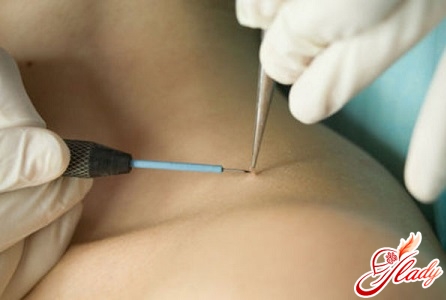 Are you getting ready to become a mom? Congratulations, because the birth of a child is a real miracle. The miracle of the birth of a new life, so fragile and defenseless. And in your power on the very first birthday of your crumb - the day of his birth - to make him the most valuable gift that can save in the future not only health, but also the life of your baby. It's about stem cells derived from umbilical cord blood in the first minutes after the birth of the baby. Treatment with stem cells has saved more than one hundred little lives. Recently, this procedure has become increasingly popular among newly-made couples. However, in spite of this, for the majority of future parents this procedure of cord blood sampling is still a curiosity. Although the cost of this procedure is not so high, there is no risk either for the child or for the mother, and people continue to regard the cord blood sampling as nothing more than a newfangled trend. Why is this happening, because the use of stem cells in modern medicine is widespread enough? In almost all cases, such erroneous judgments are caused by nothing more than the banal lack of minimal information on people about what the use of stem cells can be. This is exactly what will be discussed in today's article.
Are you getting ready to become a mom? Congratulations, because the birth of a child is a real miracle. The miracle of the birth of a new life, so fragile and defenseless. And in your power on the very first birthday of your crumb - the day of his birth - to make him the most valuable gift that can save in the future not only health, but also the life of your baby. It's about stem cells derived from umbilical cord blood in the first minutes after the birth of the baby. Treatment with stem cells has saved more than one hundred little lives. Recently, this procedure has become increasingly popular among newly-made couples. However, in spite of this, for the majority of future parents this procedure of cord blood sampling is still a curiosity. Although the cost of this procedure is not so high, there is no risk either for the child or for the mother, and people continue to regard the cord blood sampling as nothing more than a newfangled trend. Why is this happening, because the use of stem cells in modern medicine is widespread enough? In almost all cases, such erroneous judgments are caused by nothing more than the banal lack of minimal information on people about what the use of stem cells can be. This is exactly what will be discussed in today's article.
What is a stem cell?
In the blood of any person, as well as in his tissuesthere is a certain number of so-called progenitor cells that have the ability to unrestricted reproduction and degeneration into absolutely any cells of the body. Simply put, from the stem cell can turn out as a cell of bone or muscle tissue, and a cell of blood or skin. There are two types of stem cells:
- Embryonic stem cells
Embryonic stem cells are called thosecells that are isolated from the tissue of the blastocyst - an embryo, which is at an early stage of development. This type of stem cells has a huge potential for rapid growth and differentiation. However, despite this, the use of embryonic stem cells generates a huge number of disputes: they have a sufficiently high risk of degeneration into cancer, there is a risk of development of reactions of rejection and immune conflicts. In addition, the moral and ethical aspect of this issue plays an important role, since a healthy embryo is needed to receive this type of stem cells, which, accordingly, loses the birthright. Not every person agrees to treatment, which uses embryonic stem cells, which are obtained as a result of an abortion - a purposeful termination of pregnancy. Agree that there is much to argue.
- Postnatal stem cells
The same cells that are obtained from varioustissues of the already born human body (ie postnatal), have a lower potential for reproduction, since they have already used part of their natural potential. However, despite this, in modern medicine at this stage of its development, this type of stem cells is widely used for cell therapy. Postnatal stem cells, in turn, are also subdivided into two subspecies:
- Hematopoietic stem cells.
Hematopoietic called hematopoietic cells,which are part of the blood and provide transportation of oxygen to tissues, blood clotting, the work of the immune system - protection from viruses, bacteria and other foreign agents. It is these cells that are responsible for susceptibility or, on the contrary, immunity to most diseases.
- Mesenchymal stem cells.
Mesenchymal, or, as they are also called,stromal stem cells have the ability to recreate the components of any human tissue - like osteochondral cartilage and musculoskeletal, and the tissues of the heart, lungs, stomach. Stromal stem cells, in contrast to the hematopoietic stem cells, must be cultivated to successfully reproduce. By the way, if you believe the latest scientific data, in almost all tissues of the body you can find the very stem cells, however, in a different, sometimes quite small amount. Even in such seemingly unusual tissues as toothpaste, hair follicle, stem cells are also found. About the same tissues, as muscular, nervous, amniotic fluid, peripheral blood, amniotic fluid and the latter can not even be spoken. However, in spite of this, stem cells obtained far from all tissues, but only those that contain a sufficiently large number of progenitor cells, are suitable for clinical application with a view to obtaining a therapeutic effect:
- Bone marrow - it is an indispensable source of both mesenchymal and hematopoietic stem cells.
- Cord blood - it is the best source of hematopoietic cells.
- Fatty tissue, stroma of the umbilical cord and placenta - all of these are valuable sources of mesenchymal cells.
The most widely used in medicine wastransplantation of blood-forming (hematopoietic) stem cells, which are obtained from cord blood cells, peripheral blood and bone marrow tissue. To date, more than 100,000 stem cell transplants from the above sources have been produced worldwide. Stem cells extracted from umbilical cord blood account for 30% of all these transplants. The Institute of Human Stem Cells is tirelessly developing and gaining momentum. The largest number of stem cell transplants was performed during the treatment of oncological diseases, including leukemia in children and adults, both acute and chronic. The peculiarity of cancer treatment lies in the fact that the strongest pharmacological drugs destroy not only cancer cells, but also quite healthy stem cells of the patient's bone marrow. In order for the sick person to recover, and need a transplant of stem cells - either donor, or pre-prepared their own. And if in the recent past stem cells have been used mainly for the treatment of cancer patients, now more and more scientists say that the results of numerous studies suggest that in the very near future cellular therapy will be used for fundamentally new approaches to treating a large number of widespread diseases. For example, such as heart attacks, strokes, Alzheimer's and Parkinson's diseases, diabetes mellitus. The boldest forecasts predict the emergence of the possibility of cure with the help of cellular therapy irreversible to date changes on the part of virtually all vital systems of the body - bone, nervous, muscular, endocrine and others. And even those tissues and organs that wear out simply from old age, scientists also promise to restore with the help of all the same stem cells. And although today such promises can be classified as "stem cells: truth and myths", all the facts show that very soon the whole theory can be realized in practice. And then growing stem cells will be especially relevant. 
The principle of the action of stem cells
Of course, many people are interested in the principlestem cell control of the body with the disease. However, the vast majority of stem cells, with very few exceptions, do not treat the disease itself. They are destined to restore the bone marrow, the immune system and the blood of a sick person after the pharmacological and other treatments for major diseases. As already mentioned above, chemotherapeutic drugs destroy not only cancer cells in that or other organ, but also quite healthy cells of the spinal cord, without which the body simply can not exist. A timely transplantation in the literal sense of the word saves the situation - the newly introduced stem cells, having got into the bone marrow, begin to multiply and take on the role of dead cells earlier. As a result, the full functioning of the spinal cord resumes almost in full. By the way, this feature of stem cells doctors are successfully used in the fight against a number of hereditary diseases, one way or another associated with disruption of the blood, immune or exchange systems. Physicians purposefully with strong chemotherapeutic drugs destroy defective cells of the spinal cord. And in their place transplant donor stem cells, which are regenerated into healthy cells of the spinal cord. In order that the body of a sick person does not reject alien donor stem cells, doctors conduct a number of preventive measures. There are also a number of certain diseases, for the complete cure of which it is sufficient to perform transplantation of autologous (own) pre-harvested stem cells. A very important positive quality of autologous stem cells is that they are not rejected by the patient's body, since they are 100% compatible in all parameters. Thus, there is no need for long-term and expensive therapy aimed at preventing rejection reaction, which is typical for cases of transplantation of donor stem cells. To date, this type of transplantation has been used successfully to treat more than 70 different diseases, including:
- Malignant neoplasms.
- Acute myelogenous leukemia.
- Acute lymphatic leukemia.
- Neuroblastoma.
- Fanconi Anemia
- Aplastic anemia
- Various syndromes of bone marrow involvement
- Different types of immunodeficiency.
- Chronic granulomatosis.
Very actively conducted various studies anddevelopment that will successfully use stem cell transplantation for the treatment of diseases such as diabetes mellitus, kidney disease, liver, cardiovascular disease of Parkinson's and Alzheimer's disease, brain and spinal cord injuries. In addition, stem cell injections are already used in cosmetology, but we will talk about this another time.
Cord blood cells
For today it is possible to get the mostthe best stem cells from the umbilical cord, in the very first minutes after the birth of a child. These stem cells are the youngest and give the best result in comparison with all other cells of postnatal origin. In the umbilical cord blood, the overwhelming majority are the blood-forming stem cells. However, there are other types of stem cells that can be cultivated in the cells of the liver, kidneys, heart, vessels and other vital body systems. What is cord blood? As you can guess from the name, umbilical cord blood is found in the vessels and lumens of the umbilical cord and placenta, the purpose of which is to ensure the exchange of substances between the body of the pregnant woman and the fetus. To date, the most accessible and suitable source of stem cells is the umbilical cord blood. From it, mainly hematopoietic stem cells are obtained, which have practically unlimited potential for differentiation and growth. By the way, transplantation of stem cells derived from umbilical cord blood is a wonderful alternative to bone marrow transplantation. For example, in Europe, every second transplant is the transplantation of stem cells extracted from cord blood. Very many parents refuse to collect cord blood, believing that their child such a misfortune as a serious disease, will not touch. In part, they are right - the risk that a child healthy at birth, as it grows sick with acute leukemia, is very small - no more than 1: 10,000. But, nevertheless, as the child grows, including in its adult age, the likelihood of a disease with the disease, for which stem cells may be needed, especially considering that the list is constantly expanding, increases hundreds of times. Hepatic and renal insufficiency, heart attacks, strokes, diabetes, certain age-related changes - these diseases are daily visited by a huge number of people. Of course, if necessary, doctors will be able to carry out transplantation of donor stem cells. However, do not forget that donor cells, how not cool, are still alien, so the risk of developing a process of rejection is very high. In addition, the first stem cells are not suitable - sometimes it takes a huge amount of precious time to look for a donor, and this "pleasure" is not so cheap.
Arguments in favor of cord blood sampling
In the case of use for transplantationcells of the umbilical cord blood of the sick person has a huge superiority before donor transplantation - full genetic identity to the tissues of the body. This removes a whole range of issues and problems. Thus, by preserving the cord blood of their newborn baby, parents provide the child with a kind of biological health insurance for the rest of his life. This position is also fully confirmed by a number of factors:
- Duration of storage.
Stem cells extracted from umbilical cord blood can be stored in frozen form not for one or two decades, but much longer.
- Readiness for various diseases.
Of course, most probably neither you nor yourchild, and perhaps your grandchildren, stem cells will not be needed in life. In any case, I really want to hope for it. However, alas, too often doctors encounter cases when the mother of a child suffering from cancer is forced to immediately give birth to a second child. But no doctor, and nature itself, can not give such desperate women assurances that the older and younger child will be genetically compatible. In the same case, if the parents took care of collecting their child's cord blood in time, they will never have to take such extreme measures.
- Quick access to stem cells.
In the event that your child stillwill need stem cell transplantation, the doctor will only need to remove them from a special container and unfreeze, without wasting time searching for a compatible donor, alas, often completely useless.
- The price of the issue.
Many parents are embarrassed by the need to paystorages some amount for storing the stem cells of their child. However, do not forget that this cost is hundreds of times higher than the search and purchase of donor stem cells, which may not be suitable for your child.
- Potential of stem cells.
Stem cells derived from umbilical cord bloodchild, are the youngest, so they are better than all the rest not only reproduce, but also restore damaged tissues of the human body.
- Sterility and safety of stem cells.
Chances that the umbilical cord blood will be infected inthe time of fetal development is minimal. As the statistical data show, cytomegalovirus or the herpes virus is detected in umbilical cord blood in not more than one percent of all cases. In the blood of an adult, the same viruses are found in about 30% of all cases. Through the placental barrier it is almost impossible to penetrate even the ubiquitous viruses of herpes - they are hardly detected in the blood of those newborns whose mothers have been infected.
- The possibility of transplanting the child's stem cells to blood relatives.
Unfortunately, the diseases for which treatmentit is necessary to transplant stem cells, can lie in wait for any person. And they may be a close blood relative of the child - father, mother, brother or sister. Stem cells derived from umbilical cord blood, when transplanted to close relatives, give a much smaller percentage of rejection than, for example, bone marrow transplantation or transplantation of completely foreign stem cells. Thus, keeping the stem cells of crumbs, parents protect the health not only of the baby, but of the whole family.
Rules for selecting a donor
On the issue of stem cell transplantation,derived from the baby's cord blood, not to himself, but to his blood relatives, it is worth pointing. Parents often wonder, but is it possible in principle. Doctors - transplantology answer quite unequivocally: yes, it is possible. The chances of successful transplantation and success in similar, related cases are much higher than in others. The success of transplantation is entirely determined by how accurately the donor-recipient pair is selected. This compatibility is determined by special proteins - antigens. Let us consider this in more detail by the example of the "brother-sister" pair. If you are lucky and it turns out to be an ideal option, that is, a complete genetic coincidence, this means that both the boy and the girl received half of the genes from the mother, and half from the pope. And the same half. The more such mismatches there are, the higher the risk of development of the process of rejection. As a rule, almost always 100% genetic compatibility can be observed in twins, and approximately 7% compatibility is the children of one parent. Therefore, storage of stem cells makes sense. It should also be noted that in some cases, the transfusion of the umbilical cord blood itself or cells isolated from it is permissible without genetic compatibility, taking into account only the factor of Rh-compatibility. 
Families at high risk
From all of the above, a simple conclusion follows:collection of umbilical cord blood provides protection of your child's health throughout his life. However, there are families that are part of the so-called risk group. For them, the collection of umbilical cord blood of a newborn child is as relevant as ever. So:
- Cases of cancer in the family. In the event that cases of cancer have already been encountered in the child's family or close relatives, cord blood collection is highly desirable, since stem cell cancer treatment is very effective.
- Problems with health in older children. Also, umbilical blood simply needs to be collected if the baby has an older brother or sisters who suffer from a disease in which stem cell transplantation is indicated.
- The father and mother of the child are representatives ofdifferent nations. In this situation, in the event that suddenly a child in the future will need a stem cell transplant, picking them up will be extremely problematic and incredibly long. The precious time necessary to save the child's health, and possibly his life, will be irretrievably lost.
- There are three or more children in your family.
- Pregnancy was the result of extra corporal fertilization.
- The presence of any other fears that stem cells can ever be needed by your child.
How is cord blood collected?
As a rule, in all large maternity hospitalsmedical personnel have the ability to collect cord blood. Immediately after the appearance of crumbs, the umbilical cord intersects, and the umbilical cord blood is collected in a sterile, sealed container specially designed for this purpose. The entire procedure for taking cord blood takes no more than a few minutes in the period preceding the expulsion of the placenta from the uterine cavity. Many mothers worry about whether it is safe to collect cord blood for crumbs and whether it does not cause him discomfort. As is clear from the above, the cord blood sampling process is performed after the umbilical cord is crossed, the crumb in it does not take absolutely no part, and accordingly, it has no influence on the child. Another very common misconception is the belief that cord blood sampling is possible only on the condition that delivery takes place naturally, without any complications. However, in fact, this view is pure water misconception, arising from insufficiently high level of awareness. Fence of stem cells, without any problems and difficulties, is produced both in the process of natural delivery and cesarean delivery, or in the case of multiple pregnancies. When deciding on the collection of umbilical cord blood, be sure to consider the following factor. Treatment of umbilical cord blood in a specialized laboratory should be performed no more than 48 hours after its collection, provided that during storage the storage conditions were strictly observed. With each subsequent hour, the viability of stem cells is significantly reduced. That's why make sure that the stem cell clinic is within reach.
Cord Blood Tests
After the container containing umbilical cord blood gets to the laboratory, in accordance with the requirements of Russian and international standards, a number of specific tests and manipulations will be carried out:
- The Rh factor and blood group of the child will be determined.
- The number of stem cells stored in the umbilical cord blood will be counted, both before their release and after it.
- Using a special measurement, both the relative and absolute content of stem cells will be determined.
- Before the freezing process, the level of viability of all stem cells will be determined.
- Bacteriological sowing will be carried out in order to identify possible infection.
All samples pass through quarantine, and up tothe end of its term are kept separately. And only in the event that all the indicators correspond to the norm, the production of stem cells will be carried out. Stem cells will be placed in the main store of the bank, where the preservation of cord blood will continue for as long as necessary. Stem cells of umbilical cord blood are stored in cryocontainers specially designed for these purposes. These cryocontainers are either test tubes or packets of very thick and durable plastic. The fact that your baby's umbilical cord cells will be stored depends on the volume of cells.
Cord blood storage banks
It would seem that the practice of collecting and storing umbilical cordblood has appeared in Russia relatively recently. However, to date, there is a fairly large number of banks of stem cells. All of them are divided into two types:
- Banks- "registers"
In such banks, all stored samplesnameless, respectively, to determine who exactly the donor of stem cells is most often impossible. These organizations belong to state institutions that work exclusively on the basis of gratuitous assistance and voluntary donation.
- Nominal cord blood bank.
Nominal stem cells or, as they are stillcalled, family banks of personal storage, store stem cells under strict control and account. If necessary, your child's stem cells will be given out immediately, at the first request of parents or doctors. Such banks are currently working exclusively on a commercial basis. However, regardless of whether it is a state bank for storing stem cells, or whether it is commercial, it should be remembered that it is a matter of providing highly specialized medical services. And this means that the activity of any bank of cord storage should be exclusively licensed. Summarizing the results of today's conversation, we can say the following: when we bring to the family council the question "cord blood - for and against," remember that the old saying goes "cut seven times - cut once". Such an opportunity to get personal health insurance from the very nature of your child will never be in life again. Of course, we wholeheartedly wish you never to feel the need to use stem cells. Be healthy! We advise you to read:









